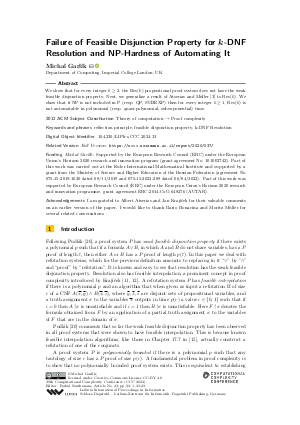@InProceedings{garlik:LIPIcs.CCC.2024.33,
author = {Garl{\'\i}k, Michal},
title = {{Failure of Feasible Disjunction Property for k-DNF Resolution and NP-Hardness of Automating It}},
booktitle = {39th Computational Complexity Conference (CCC 2024)},
pages = {33:1--33:23},
series = {Leibniz International Proceedings in Informatics (LIPIcs)},
ISBN = {978-3-95977-331-7},
ISSN = {1868-8969},
year = {2024},
volume = {300},
editor = {Santhanam, Rahul},
publisher = {Schloss Dagstuhl -- Leibniz-Zentrum f{\"u}r Informatik},
address = {Dagstuhl, Germany},
URL = {https://drops.dagstuhl.de/entities/document/10.4230/LIPIcs.CCC.2024.33},
URN = {urn:nbn:de:0030-drops-204295},
doi = {10.4230/LIPIcs.CCC.2024.33},
annote = {Keywords: reflection principle, feasible disjunction property, k-DNF Resolution}
}

 Creative Commons Attribution 4.0 International license
Creative Commons Attribution 4.0 International license






